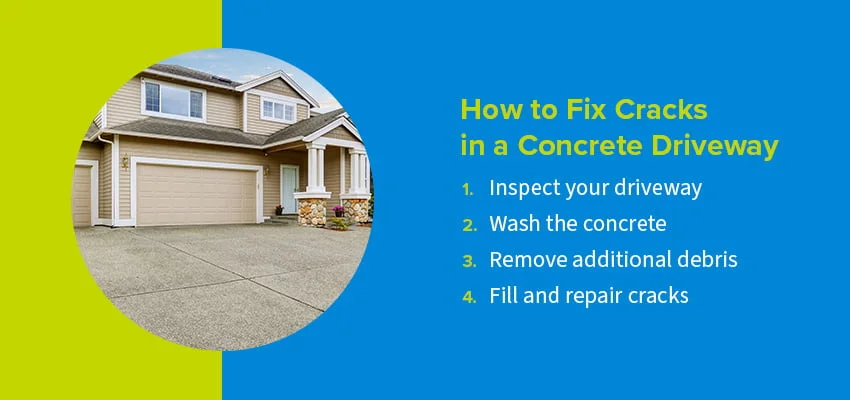A quality driveway can last a long time, withstanding the harsh elements and bearing the weight of heavy vehicles. However, your driveway will show signs of wear and tear throughout the years like any other part of your home.
Repairing your driveway can ensure a safe path for driving and walking. Fixing your driveway is also essential if you plan to sell your home, especially if other homes in the area have smooth, well-maintained driveways.
Learn more below about the predominant types of driveways, fixing driveway cracks and what to do if the damage is extensive.
Concrete vs. Asphalt Driveways
The most common types of driveway materials are concrete and asphalt. Both use crushed stone and sand, also known as aggregate, and bind them together using one of the two materials. Here are the main differences between the two types of driveways:
- Concrete: These driveways use cement as the main ingredient to bind the aggregate together. The cement mixture utilizes water, rock, clay and aggregate to create a strong foundation. A cement driveway can simply look like cement or be stamped to look like paver stones or brick.
- Asphalt: In an asphalt driveway, aggregate is bound together using a petroleum-based material — asphalt — that’s comparable to tar. These driveways are often referred to as blacktop, as they’re dark in color.
Ideally, neither concrete nor asphalt would become damaged or cracked. However, time, nature and other environmental influences can damage even the most quality of driveways.
How to Fix Cracks in a Concrete Driveway
If you start to see damage on your concrete driveway, follow these steps to repair it:
- Inspect your driveway: Before starting the repair process, you need to inspect your driveway to determine the extent of the damage and the materials you’ll need to repair the damage. Use a tape measure or ruler to get an accurate gauge of what you need. When you find a crack or damage, you should chip away at crumbling or soft concrete to ensure that the gap is wider below the surface than at the top.
- Wash the concrete: Now that you’ve assessed the damage, it’s time to start washing the concrete. Consider using a power washer for the most efficient cleaning experience. Begin from the middle of the driveway and work your way outward, ensuring the dirt doesn’t come back to areas you’ve already cleaned. Using a brush, you can also apply environmentally safe detergent and work it into the surface. Use a hose or the power washer to remove the detergent and dirt. Then, let it dry.
- Remove additional debris: Use a shop vacuum to eliminate the remaining dirt from the cracks and ensure everything is completely dry before fixing the damage.
- Fill and repair cracks: Apply a bonding adhesive, vinyl patching compound or primer to ensure the old material bonds well with the patching material. Any larger cracks will require foam backer rods to support them and prevent them from worsening. Fill all cracks. Cover big sections with a plastic sheet until the material sets. Follow the manufacturer’s instructions on your chosen material to stay safe and ensure each crack is fixed properly.

How to Fix Cracks in an Asphalt Driveway
If you have an asphalt driveway instead of a concrete driveway, you may need to take a few different steps to fix any damage or cracks:
- Clean your driveway: Before fixing the holes or cracks in your driveway, start by cleaning away any debris from the asphalt. Use a broom or leaf blower to eliminate leaves and dust and a pressure washer to eliminate any pesky stains.
- Patch holes or cracks: Patching cracks and holes ahead of time will give you the best results. Use crack filler for minor cracks and a driveway patch for larger cracks. Ensure you don’t overfill cracks so they’re not visible under the sealant. If you overfill the cracks, you can always use a scraper to level it out.
- Clean and mix sealant: After filling the cracks and holes, give the driveway another pass-over with your broom or leaf blower. Start mixing your sealant to have it ready by the time you need to apply it to the asphalt.
- Seal the edge: Sealing the edge of the driveway first can help prevent any sealant from spilling over the edge. Work your way around the edge and on any place where the driveway meets any structure. Be more precise by using a paintbrush, making it look as good as when it was first laid down.
- Seal the remaining asphalt: Now that you’ve sealed the edges, you can pour the sealant on the remaining asphalt. Use a squeegee to move the sealant around, using the right amount of pressure to keep the coverage even. The sealant will need to cure for 24 hours, so wait to do so until the next couple of days are clear and sunny. Apply a second coat once it’s cured to ensure each space is cured evenly.
When Is the Crack Too Big to Repair?
If you need to patch small driveway cracks or holes, it’s simple to do so on your own. However, some cracks are too big to repair on your own and require professional assistance to resurface. In some cases, you may need to completely replace the driveway to bring it back to its pristine form.
A professional can help you assess the extent of the damage and give you a better idea of the work that needs to be done. While professional repairs can be expensive, the appearance of your driveway could affect your home’s value and ability to sell, so it may be a worthwhile investment.
Don’t Let Your Home’s Condition Hold You Back From Selling
HomeGo will buy your home as-is, regardless of its condition. Once we conduct our walkthrough, we’ll determine the value of your home and give you an offer the same day. You can close the deal with us in as little as seven days, allowing you to move whenever you’re ready.
We also offer a leaseback program, which will enable you to stay in your home after the deal, giving you time to pack or prepare to move. Schedule a walkthrough today to get started or contact us to learn more about how we can help.





